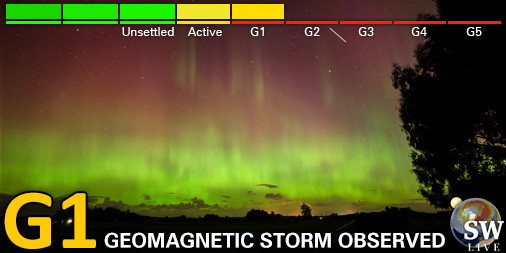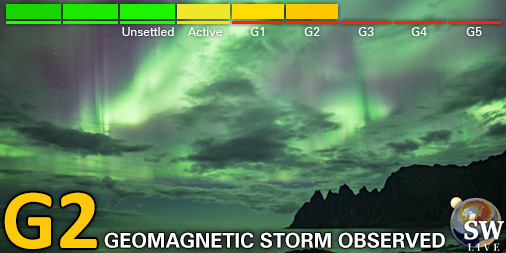Viewing archive of Thursday, 12 April 2001
Solar activity report
Any mentioned solar flare in this report has a scaling factor applied by the Space Weather Prediction Center (SWPC). Because of the SWPC scaling factor, solar flares are reported as 42% smaller than for the science quality data. The scaling factor has been removed from our archived solar flare data to reflect the true physical units.
Report of Solar-Geophysical Activity 2001 Apr 12 2200 UTCPrepared by the NOAA © SWPC and processed by SpaceWeatherLive.com
Joint USAF/NOAA Report of Solar and Geophysical Activity
SDF Number 102 Issued at 2200Z on 12 Apr 2001IA. Analysis of Solar Active Regions and Activity from 11-2100Z to 12-2100Z
Solar activity was high. Region 9415 (S22W43) produced
an X2 flare at 12/1028 UTC. This flare was not optically correlated
at the peak time of the event, however EIT imagery and later optical
flare observations have associated this flare with Region 9415. This
event was accompanied by Type II and IV radio sweeps, a 1200 sfu 10
cm radio burst, and a full-halo coronal mass ejection (CME). Region
9415 also produced an M1/1n event at 12/0304 UTC. Several other
regions developed into more complex sunspot classification groups,
but showed very little activity during the period.
IB. Solar Activity Forecast
Solar activity is expected to be at
moderate to high levels. Region 9415 could possibly produce another
major flare during the period.
IIA. Geophysical Activity Summary 11-2100Z to 12-2100Z
The geomagnetic field ranged from unsettled to severe storm levels.
The geomagnetic field continued to be disturbed early in the period
due to CME shock arrivals at earth on 11 April. The storm subsided
to unsettled conditions toward the end of the period. The solar
radiation storm that was in progress for the last two days has been
extended by protons produced from today's X2 event. The greater than
10 MeV proton flux was at high levels all period. The greater than
100 MeV protons reached threshold levels at 12/1305 UTC and remained
at or above threshold levels for the remainder of the period. A
polar cap absorption (PCA) event was in effect for most of the
period.
IIB. Geophysical Activity Forecast
The geomagnetic field is
expected to be quiet to active for the first part of the period
until the arrival of an earth directed CME from the M2/1f event that
occurred on 11/1326 UTC. This CME should arrive at earth sometime
late on 13 April or early 14 April UTC. A second CME from today's X2
event should arrive at earth late on 14 April or early 15 April UTC.
Both arrivals should produce active to major storm levels with brief
severe storm levels at high latitudes possible. The greater than 10
MeV proton event is expected to continue through most of the period.
The PCA event is expected to end during the latter half of the
period.
III. Event Probabilities 13 Apr to 15 Apr
| Class M | 80% | 80% | 80% |
| Class X | 25% | 25% | 25% |
| Proton | 80% | 60% | 25% |
| PCAF | in progress | ||
IV. Penticton 10.7 cm Flux
Observed 12 Apr 149 Predicted 13 Apr-15 Apr 150/145/140 90 Day Mean 12 Apr 167
V. Geomagnetic A Indices
Observed Afr/Ap 11 Apr 069/060 Estimated Afr/Ap 12 Apr 045/050 Predicted Afr/Ap 13 Apr-15 Apr 040/020-050/050-025/040
VI. Geomagnetic Activity Probabilities 13 Apr to 15 Apr
| A. Middle Latitudes | |||
|---|---|---|---|
| Active | 15% | 15% | 35% |
| Minor storm | 20% | 25% | 15% |
| Major-severe storm | 40% | 45% | 10% |
| B. High Latitudes | |||
|---|---|---|---|
| Active | 35% | 25% | 40% |
| Minor storm | 25% | 30% | 25% |
| Major-severe storm | 15% | 40% | 20% |
All times in UTC
Current data suggests there is a slight possibility for aurora to appear at the following high latitude regions in the near future
Whitehorse, YT, Yellowknife, NTAnchorage, AK, Fairbanks, AK, Juneau, AK, Utqiagvik, AK
Latest news
Latest forum messages
Unspecified geomagnetic activity 2221Incoming & Unnumbered Active Regions 1660AR4048 114New satellites - Proba-3, PUNCH, SWFO-L1, GOES-U/19 36Filaments and prominences 750
More topicsSupport SpaceWeatherLive.com!
A lot of people come to SpaceWeatherLive to follow the Sun's activity or if there is aurora to be seen, but with more traffic comes higher server costs. Consider a donation if you enjoy SpaceWeatherLive so we can keep the website online!

Latest alerts
10:00 UTC - Hemispheric Power Index
The OVATION model predicts the Hemispheric Power Index to reach 78GW at 10:32 UTC
04:15 UTC - Geomagnetic activity
Minor G1 geomagnetic storm (Kp5) Threshold Reached: 04:05 UTC
03:15 UTC - Geomagnetic activity
Moderate G2 geomagnetic storm (Kp6) Threshold Reached: 02:59 UTC
01:00 UTC - Geomagnetic activity
Minor G1 geomagnetic storm (Kp5) Threshold Reached: 00:51 UTC
Friday, 4 April 2025
23:30 UTC - Geomagnetic activity
Minor G1 geomagnetic storm (Kp5) Threshold Reached: 23:17 UTC
Space weather facts
| Last X-flare | 2025/03/28 | X1.1 |
| Last M-flare | 2025/04/01 | M2.5 |
| Last geomagnetic storm | 2025/04/04 | Kp5+ (G1) |
| Spotless days | |
|---|---|
| Last spotless day | 2022/06/08 |
| Monthly mean Sunspot Number | |
|---|---|
| March 2025 | 134.2 -20.4 |
| April 2025 | 148 +13.8 |
| Last 30 days | 130.9 -15.2 |






